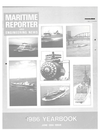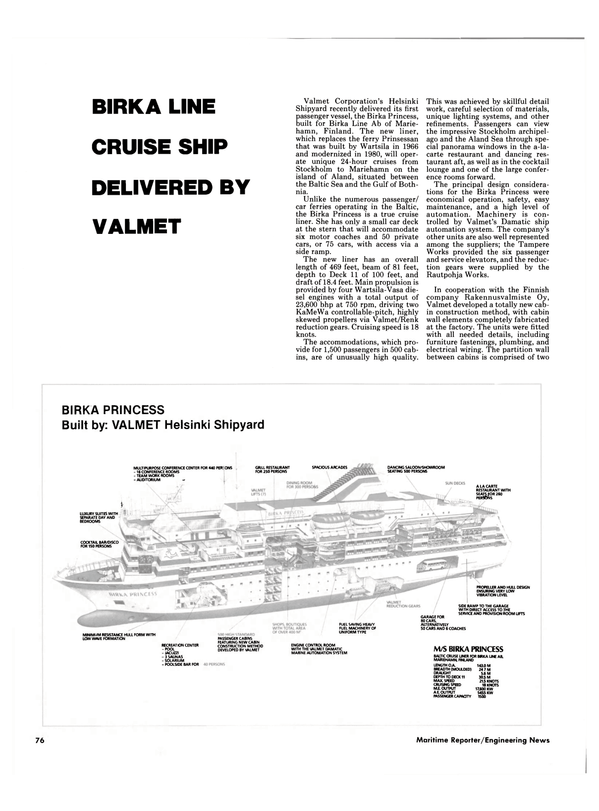
BIRKA LINE CRUISE SHIP DELIVERED BY VALMET
Valmet Corporation's Helsinki Shipyard recently delivered its first passenger vessel, the Birka Princess, built for Birka Line Ab of Mariehamn, Finland. The new liner, which replaces the ferry Prinsessan that was built by Wartsila in 1966 and modernized in 1980, will operate unique 24-hour cruises from Stockholm to Mariehamn on the island of Aland, situated between the Baltic Sea and the Gulf of Bothnia.
Unlike the numerous passenger/ car ferries operating in the Baltic, the Birka Princess is a true cruise liner. She has only a small car deck at the stern that will accommodate six motor coaches and 50 private cars, or 75 cars, with access via a side ramp.
The new liner has an overall length of 469 feet, beam of 81 feet, depth to Deck 11 of 100 feet, and draft of 18.4 feet. Main propulsion is provided by four Wartsila-Vasa diesel engines with a total output of 23,600 bhp at 750 rpm, driving two KaMeWa controllable-pitch, highly skewed propellers via Valmet/Renk reduction gears. Cruising speed is 18 knots.
The accommodations, which provide for 1,500 passengers in 500 cabins, are of unusually high quality.
This was achieved by skillful detail work, careful selection of materials, unique lighting systems, and other refinements. Passengers can view the impressive Stockholm archipelago and the Aland Sea through special panorama windows in the a-lacarte restaurant and dancing restaurant aft, as well as in the cocktail lounge and one of the large conference rooms forward.
The principal design considerations for the Birka Princess were economical operation, safety, easy maintenance, and a high level of automation. Machinery is controlled by Valmet's Damatic ship automation system. The company's other units are also well represented among the suppliers; the Tampere Works provided the six passenger and service elevators, and the reduction gears were supplied by the Rautpohja Works.
In cooperation with the Finnish company Rakennusvalmiste Oy, Valmet developed a totally new cabin construction method, with cabin wall elements completely fabricated at the factory. The units were fitted with all needed details, including furniture fastenings, plumbing, and electrical wiring. The partition wall between cabins is comprised of two PVC-coated steel sheets backed by a 15-mm layer of mineral wool, with a 40-mm air gap between. This insures the best possible sound insulation between cabins.
The main navigation equipment in the spacious wheelhouse is concentrated in a cockpit type desk, making it possible for one man to control the navigation of the ship in a sitting position. The radar system is from Racal-Decca; it comprises one 10-cm ARPA radar that is interswitched with a 3-cm true motion unit.
The ARPA radar antenna is installed on the mast atop the wheelhouse, with the 3-cm antenna on the radar mast on the forecastle deck. In addition, there is a third independent 10-cm radar with a true motion display and an antenna atop the wheelhouse. Other navigation equipment includes a Raytheon DSN-450 dual-axis doppler speed log, a Simrad ED 61 echo sounder with a digital repeater, and an Anschutz Standard 4 gyrocompass.
The partially enclosed lifeboats supplied by Fiskars have a total capacity of 536 persons. The 62 davit- launchable life rafts supplied by Viking each have a capacity of 25 persons. All lifeboat and life raft davits are equipped with a remote control for the brake.
For additional information on Valmet's shipbuilding facilities and capabilities, Circle 49 on Reader Service Card
Read BIRKA LINE CRUISE SHIP DELIVERED BY VALMET in Pdf, Flash or Html5 edition of June 1986 Maritime Reporter
Other stories from June 1986 issue
Content
- Zapata Gulf Acquires All Assets Of Seahorse page: 5
- Rody Selects AWSC Committee Chairmen page: 5
- Danos & Curole Continue Long-Range Expansion In Marine Department page: 5
- Contract With $25-Million Potential Awarded Rockwell page: 6
- Nelson Electric Names Sanchez Sales Manager page: 6
- Bailey Refrigeration Goes On Site For Work Aboard Navy Aircraft Carrier page: 7
- Navy Awards $73.7-Million Crane Contract To Craft Machine page: 7
- ABS Elects New Members To Board Of Managers page: 8
- ASNE Symposium-1986 Set For October 2-4 In Biloxi, Miss. page: 8
- Ulstein Delivers Two Tug/Supply Vessels To Norwegian Owners page: 10
- Derecktor Delivers First Of Two Ferries To New York City page: 11
- AWO Elects Officers For 1986 At Annual Convention In Washington page: 11
- Pentagon Approves $216-Million Sale To Portugese Navy page: 12
- Sophisticated Catcher/Processor Delivered By Halter Marine page: 12
- ODECO Wins 1986 NOIA Safety In Seas Award page: 12
- Pickands Mather Promotes Three In Marine Department page: 13
- Monsanto Offers Free 12-Page Bulletin On Fluid Resistance Of Santoprene® page: 14
- Port Of Portland Budget Includes Funds For Marine Improvements page: 15
- American Bureau Names Twenty-Five New Members page: 15
- Port Authority In Malaysia Orders Voith Water Tractor page: 16
- Gastech 85 "Proceedings' Now Available page: 16
- Metos Marine Offers New Cabin Fitting Concept page: 17
- Meyer Werft Launches Two Sister Passenger Ships For Indonesia page: 18
- Fairbanks Morse Invests In Future— Expands Parts/Service Operations, Increases Production And R&D page: 20
- Borg-Warner Changes Name To York International page: 23
- Passenger Catamaran To Operate Between Seattle And Victoria page: 24
- U.S. SHIPBUILDING $Billions In Navy Work Plus Repairs Brighten The Picture page: 26
- STATUS OF NAVY SHIP PROCUREMENT page: 32
- U.S. SHIPBUILDING OUTLOOK Maritime Policy—1980-1985 page: 40
- U.S. SHIPBUILDING INDUSTRY HAS MADE GREAT STRIDES IN IMPROVING EFFICIENCY AND REDUCING COSTS page: 44
- Our Transportation Policy Is No Transporation Policy page: 46
- REGULATORY OVERKILL PERSERVERES page: 48
- AWSC And The Industry: Working For The Future page: 50
- Offshore Service Vessels, Tugboat And Inland Towboat Fleets page: 52
- CANADIAN SHIPBUILDING REVIEW AND OUTLOOK page: 63
- World Shipping And Shipbuilding page: 65
- Port of Iberia Inaugurates New Public Dock Facility page: 72
- Amhoist Announces $33 Million In Crane And Puller Orders page: 72
- Hancock Succeeds Loftus As Comptroller And Deputy Commander Of NAVSEA page: 73
- Gastech 86 Scheduled For November In Hamburg page: 73
- Technical Report On Liner And Bulk Planning Systems Offered By MarAd page: 74
- Todd's San Pedro Yard Gets Preliminary Approval As Foreign Trade Subzone page: 74
- Beclawat Offers Windows & Doors For Ships And Rigs page: 74
- Wartsila Unit Offers Vacuum Toilet System page: 75
- Ship Structure Committee Releases New Reports On Design And Safety Topics page: 75
- BIRKA LINE CRUISE SHIP DELIVERED BY VALMET page: 76
- American Management Now Provides Services For Commercial Ships page: 77
- Two More Firms Approve Use Of Ameroid® OWS page: 77
- MarAd Invites Proposals To Provide Vessel For Schoolship Conversion page: 77
- Port Authority Urges $56.5-Million In Funds For N.Y. Harbor Improvements page: 78
- Marine Travelift Offers Full-Color Brochure On 250-Ton Mobile Boat Hoist page: 78
- Bailey Controls Offers 18-Page Technical Paper On 0 2 / C 0 Boiler Control page: 78
- William O'Malley Named Executive VP At Sonat page: 79
- Free Literature Available On Long-Life Marine Window Wipers For Ships page: 79
- Jane's Publishing Offers Facsimile Edition Of First World's Fighting Ships page: 80
- Baldt Offers Military Shipbuilding Brochure page: 80
- York International Offers Brochure On Water Chilling And Condensing Units page: 81
- Norsk Pacific Announces Management Changes— Stenstrom Named President page: 81
- Deepwater, Heavy-Duty Jackup Joins Blue Streak Marine Fleet page: 82
- New Brochure Offered By Warren Describes Barge Pump Line page: 82
- M.A.N.-B&W Turbochargers Reduce Fuel Consumption page: 83
- SNAME Announces Standing Special And Technical Committees For 1986 page: 84
- Free 72-Page Catalog Describes New Falk Worm Gear Speed Reducers page: 85
- Free Full-Color Bulletin On AQP Spiral Wire Hose Offered By Aeroquip page: 86
- PRMMI Names Four To Key Sales Positions page: 86
- MHI Develops High-Pressure Gas Injection DFD Engine page: 87
- Free Four-Page Brochure Offered On Acorn Platens page: 87
- 'New' High-Speed Ferry Boosts Boston Area Commuter Service page: 88
- Microphor Offers New Four-Color Brochure On Marine Heads page: 89
- Cat Pumps Introduces Two N e w Stainless Steel Pumps page: 90
- Polarmarine Introduces New Concept In Tank Cleaning page: 91
- Tampa Shipyards Delivers Fifth Products Tanker To Ocean Shipholdings page: 92
- Caterpillar 3600 Series Now Qualified On 1,500 Redwood Fuel page: 92
- Bailey Controls Opens New Demonstration Facility page: 93
- Ulstein Maritime Reports On Z-Drive Success page: 94
- Degree In Small Craft Naval Architecture Offered By YDI Schools page: 95
- Montreal Group Plans To Modernize 150-Year-Old Yard In Nova Scotia page: 96
- Atlas-Danmark Expands Line Of Sludge/Waste Incinerators page: 97
- '86 Ship Production Symposium Scheduled For August in Williamsburg page: 98
- Sulzer Diesels Will Power Townsend Cross-Channel Passenger/Vehicle Ferries page: 99
- Marathon Offers Full-Color Brochure On Metal Fabrication Services page: 102
- Free 12-Page Catalog On Combustion, Pollution And Energy Control Equipment page: 102
- Free 16-Page Full-Color Brochure On Compressors Offered By Atlas Copco page: 103
- MM A Meeting Draws Immediate Return Engagement By DLA's General Morgan page: 104
- SAIT Radio Telex Now Compatible With IBM PC page: 104
- New York City Marine Society Celebrates 216th Annual Dinner page: 106
- Blount Marine Delivers 64-Foot Ferry To Prudence Island Navigation page: 109
- First Two Of Ten Bulkers For Greek Owner Christened At Hyundai page: 115
- The Shipmate RS-2000 Color Track Plotter page: 115
- MacGregor-Navire Link Span Installed At Port Of Plymouth page: 118
- Cathodic/Electrolytic Engineers Offer Replacement Anode Service For Antifouling Systems page: 119
- Record Land And Marine Lifts Set By Amhoist Cranes page: 119


